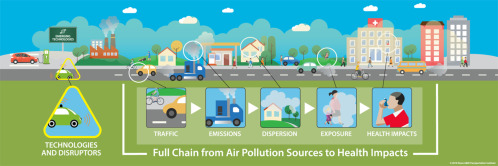The associations between traffic-related air pollution (TRAP) and numerous health effects have been established in epidemiology and emerging health effects are continuously being studied. This book synthesizes the state-of-the-art knowledge on TRAP and human health. The SDG goal 3.9.1 is to reduce the mortality rate attributed to household and ambient air pollution.
This chapter provides an overview of some of the ethical issues raised by the emergence of global mental health as a distinct field as well as supporting calls for a more inclusive bioethics paradigm for considering health on a global scale.
Elsevier,
Mental and Behavioral Health of Immigrants in the United States: Cultural, Environmental, and Structural Factors, Volume , 1 January 2020
The immigrant population of the United States is expected to increase over the coming years, and the constant influx of new immigrants will mix in with previous generations of immigrants. This chapter reviews current literature that proves immigrants are susceptible to various mental health conditions such as depression, anxiety, and posttraumatic stress disorder (PTSD) due to a wide array of psychological and emotional distress from the immigration and acculturation process.
This chapter explores the utility of various therapeutic modalities, including their method of delivery, in working with older adults, which can lead to better health and well-being for individuals.
The chapter provides an overview of the mechanisms and factors likely to influence mental health and access to care of ethnic minority older adults.
Mental health and human rights are both global concerns that have been shaped by two complementary discourses: the human rights of mental health patients, and mental health care as a human right. Both discourses have influenced the development of strategies to better understand and address—at a global scale—the mental health treatment gap.
An Article in support of SDGs 2 and 12, analysing the affordability of the EAT–Lancet benchmark diets using food price and household income data for 744 foods in 159 countries, collected under the International Comparison Program.
The Internet continues to be a widely used resource to access mental health information. However, the overall low quality of online mental disorder information, with the possible exception of that for mood disorders, raises concerns that consumers may be receiving an incomplete or inaccurate picture of their disorder of interest or concern. Ongoing evaluations of website quality are needed to ensure that consumers are empowered with accurate and usable information for good health and well being.
Mental health problems are widely recognized as a major public health challenge worldwide. This highlights the need for effective tools for detecting mental health disorders in the population. Social media data is a promising source of information where people publish rich personal information that can be mined to extract valuable psychological information. However, social media data poses its own set of challenges, such as the specific terms and expressions used on different platforms, interactions between different users through likes and shares, and the need to disambiguate between statements about oneself and about third parties.
To understand the Twitter network of an environmental and political event and to extend the network theory of social capital, the authors performed a network analysis of the English tweets during the first 10 days of the United Nations’ Conference of the Parties in Paris in 2015.

